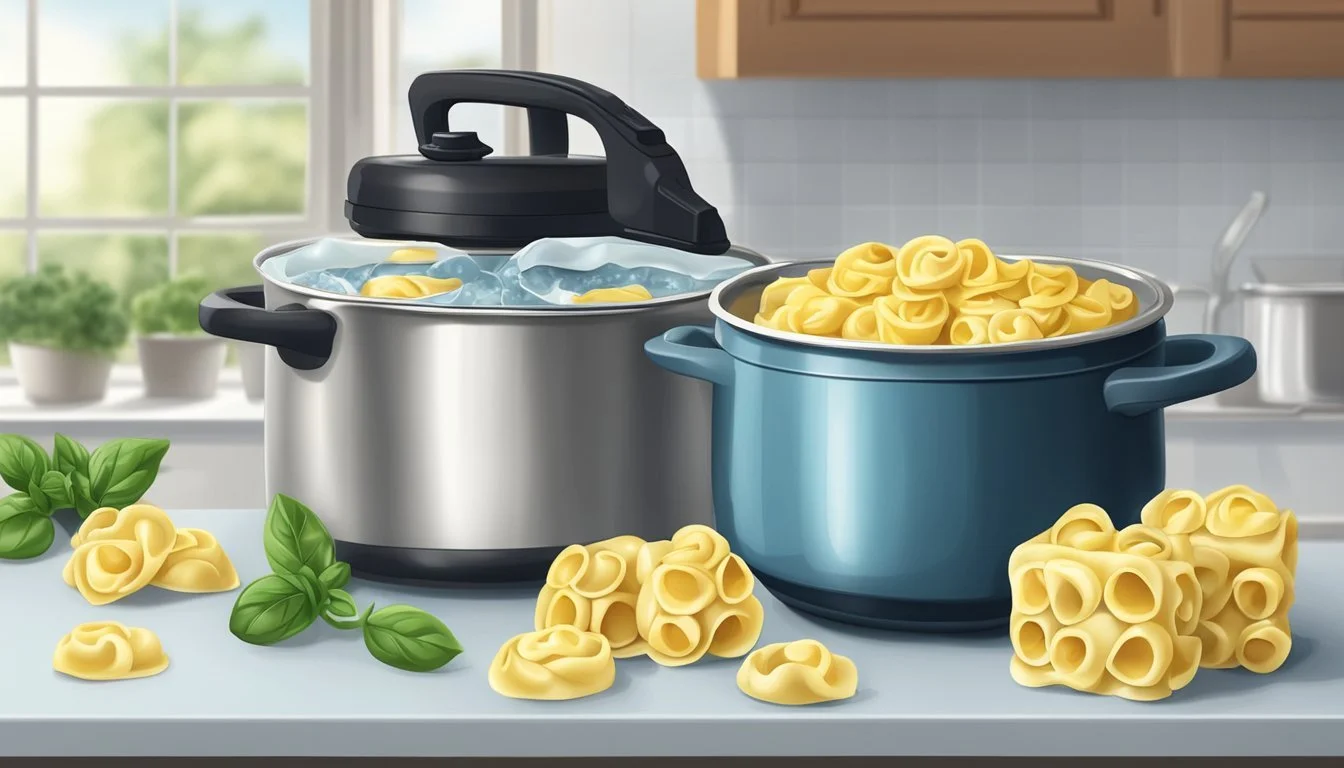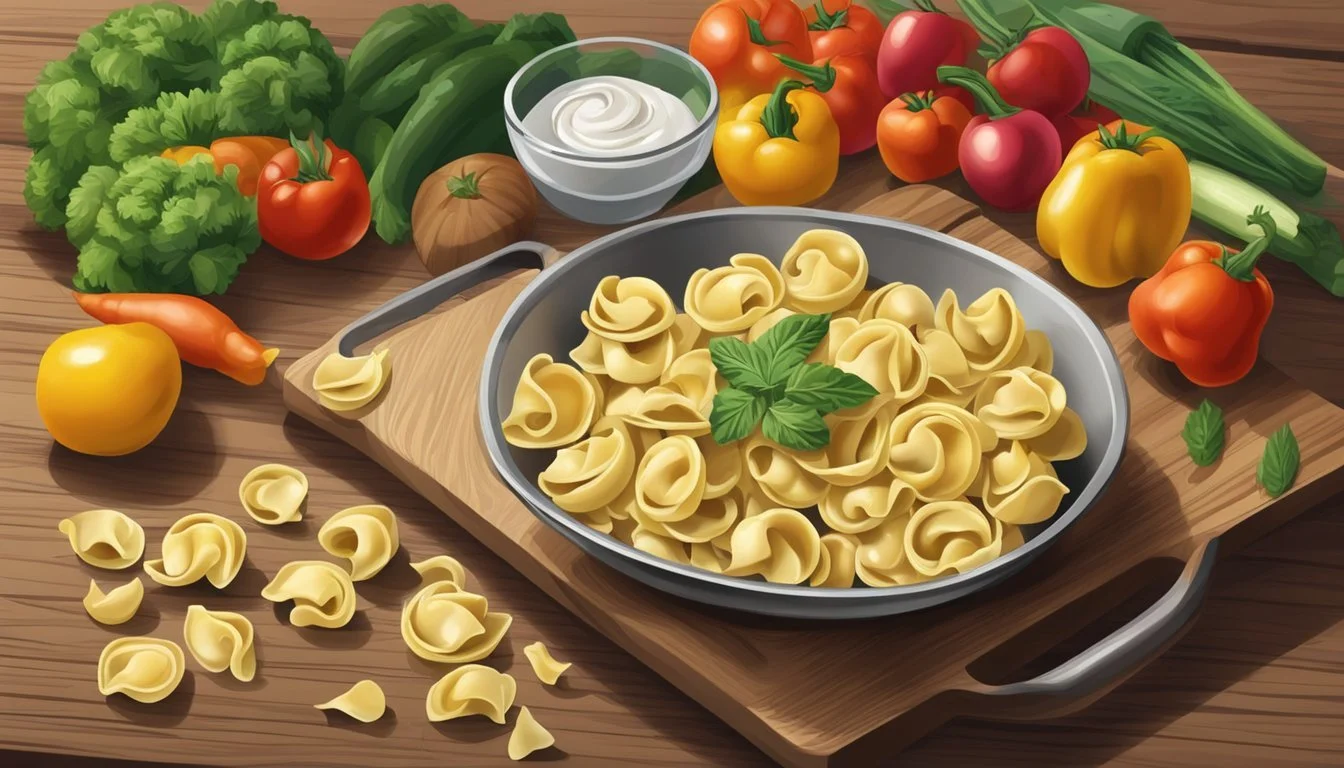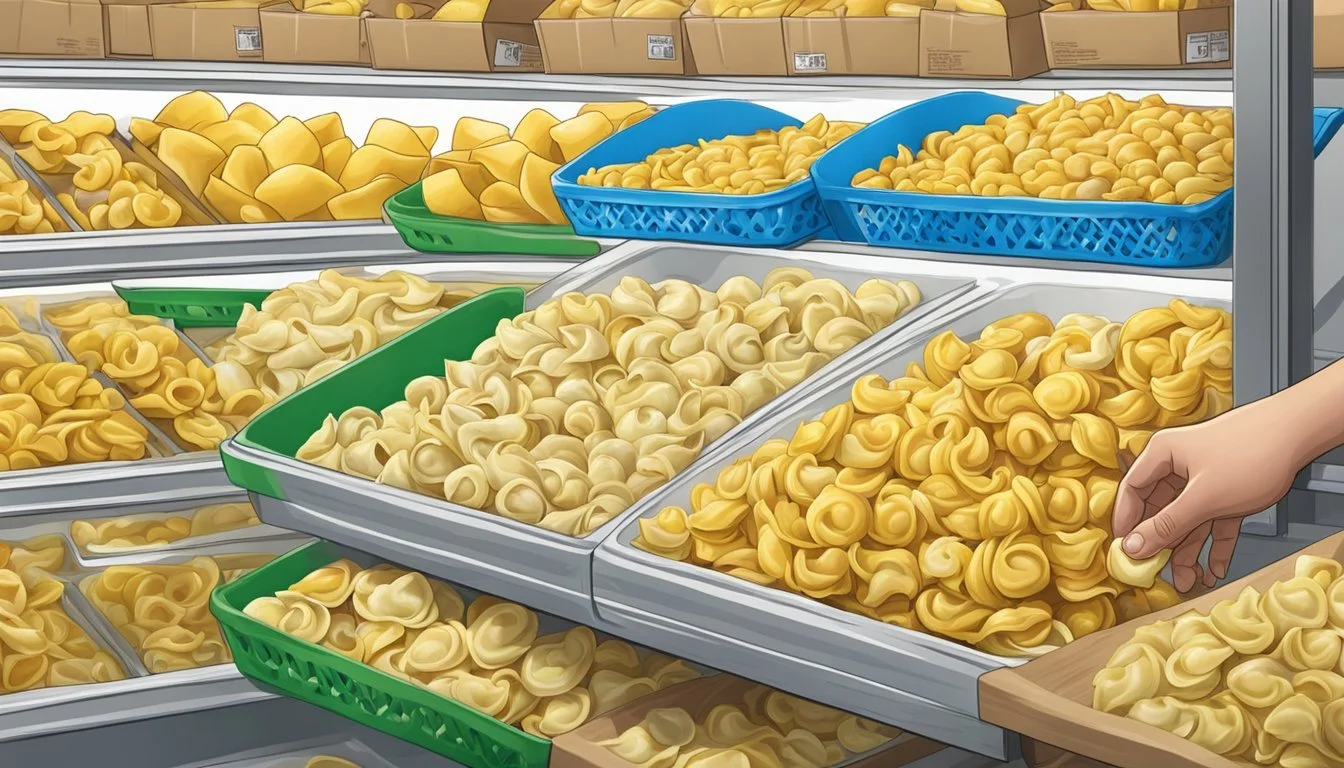Fresh vs Frozen Tortellini: A Taste and Convenience Comparison
Tortellini, those delightful little pasta rings stuffed with cheese or meat, can be found in both fresh and frozen varieties at most grocery stores. While both options offer convenience, there are notable differences in taste, texture, and cooking methods.
Fresh tortellini typically provides superior flavor and texture compared to its frozen counterpart. The pasta retains a delicate chewiness and the fillings taste brighter and more vibrant. Fresh tortellini cooks quickly, usually in just 3-5 minutes, making it ideal for fast weeknight meals or adding to soups right before serving.
Frozen tortellini offers longer shelf life and can be a handy pantry staple. It requires slightly longer cooking times but still prepares relatively quickly. In taste tests, brands like Rana and Buitoni often rank highly for both fresh and frozen options. When choosing between fresh or frozen, consider factors like availability, price, and how soon you plan to use the pasta.
Understanding Tortellini
Tortellini is a beloved Italian pasta with a rich history and diverse varieties. This ring-shaped pasta offers unique textures and flavors in both fresh and frozen forms.
Origins and Types
Tortellini originated in the Emilia region of Italy, specifically in Bologna. Legend says its shape was inspired by Venus's navel. Traditional tortellini is small, typically 2-3 cm in diameter. Tortelloni is a larger variation.
Fillings vary but often include cheese, meat, or vegetables. Popular types include:
Three-cheese tortellini
Pesto tortellini
Meat-filled tortellini
Some brands offer specialty flavors like spinach or mushroom. The pasta itself can be plain or flavored, such as tomato or spinach dough.
Fresh vs. Frozen Tortellini
Fresh tortellini is typically found in refrigerated sections of stores. It has a shorter shelf life, usually 1-2 weeks. The texture is often more delicate and the flavors more pronounced.
Frozen tortellini can last several months in the freezer. It's convenient for quick meals. The texture may be slightly firmer than fresh.
Fresh tortellini works better in soups, as it absorbs flavors well without becoming mushy. Frozen varieties are ideal for baked dishes or quick pan-frying.
Both types cook quickly. Fresh tortellini usually takes 3-5 minutes, while frozen may need 5-7 minutes. Always follow package instructions for best results.
Key Differences Between Fresh and Frozen Tortellini
Fresh and frozen tortellini offer distinct qualities that impact their preparation, texture, and taste. These differences stem from their storage methods and production processes.
Preparation and Cooking Time
Fresh tortellini requires minimal preparation and cooks quickly. It often needs only 2-3 minutes in boiling water to reach al dente perfection. Refrigerated varieties typically have a shelf life of 1-2 weeks.
Frozen tortellini demands longer cooking times, usually 5-7 minutes. It can be stored in the freezer for several months, offering convenience and extended shelf life. No thawing is necessary; the pasta can be added directly to boiling water.
Both types benefit from gentle stirring during cooking to prevent sticking. Fresh tortellini is more delicate and requires careful handling to maintain its shape.
Texture and Taste Considerations
Fresh tortellini generally offers a superior texture. The pasta maintains a tender yet firm bite, with a smooth exterior. Its filling often has a more pronounced flavor and creamier consistency.
Frozen tortellini can sometimes have a slightly tougher exterior due to the freezing process. However, high-quality brands maintain good texture. The filling may be less pronounced in flavor compared to fresh varieties.
Moisture content differs between the two. Fresh tortellini has higher moisture, resulting in a softer mouthfeel. Frozen tortellini may absorb more sauce due to its slightly drier nature.
Seasoning can vary. Fresh tortellini often has more vibrant flavors, while frozen versions might require additional seasoning during cooking. Both types are versatile and can be used in various dishes, from soups to pasta salads.
Selecting the Right Tortellini
Choosing quality tortellini involves examining options in the refrigerated section and considering various fillings and flavors. Fresh tortellini offers superior taste and texture compared to frozen varieties.
Spotting Quality in the Refrigerated Section
Look for tortellini with a smooth, uniform appearance and no signs of drying or cracking. Check the expiration date to ensure freshness. Reputable brands like Giovanni Rana and Buitoni often provide high-quality options.
Examine the packaging for proper sealing to prevent moisture loss. Fresh tortellini should feel slightly moist to the touch, not dry or sticky. Avoid packages with excess liquid, which may indicate improper storage or thawing.
Store-bought tortellini is typically found in the refrigerated section near other fresh pastas. Some grocers may offer housemade varieties in their deli or prepared foods area.
Deciding on Fillings and Flavors
Classic cheese tortellini often contains a blend of ricotta, parmesan, and mozzarella. More adventurous options include spinach and cheese, mushroom, or meat-filled varieties with prosciutto, mortadella, or veal.
Consider the sauce you'll be using when selecting a filling. Cheese tortellini pairs well with tomato-based sauces, while meat-filled options complement cream sauces. For a unique twist, try artichoke-filled tortellini with a light olive oil dressing.
Taste preferences vary, so experiment with different fillings to find your favorite. Some brands offer sampler packs with multiple flavors for easy comparison.
Preparing and Serving Tortellini
Tortellini offers versatility in preparation and serving methods. This pasta can be cooked using various techniques and paired with a range of sauces and ingredients to create delicious meals.
Cooking Techniques
Boiling in salted water is the most common method for cooking tortellini. Bring a pot of water to a boil, add salt, then gently add the tortellini. Fresh tortellini cooks in 3-5 minutes, while frozen may take 5-7 minutes. Stir occasionally to prevent sticking.
For a quicker option, use the microwave. Place tortellini in a microwave-safe bowl with water, cover, and cook on high for 3-4 minutes, stirring halfway through.
Instant Pot cooking is another efficient method. Add tortellini and water to the pot, seal, and cook on high pressure for 0-1 minute, depending on whether it's fresh or frozen.
Pairing with Sauces and Ingredients
Tortellini pairs well with various sauces and ingredients. Tomato-based sauces like marinara complement cheese-filled tortellini. For a richer option, try Alfredo or a cream sauce.
Pesto sauce adds a burst of flavor to tortellini dishes. Toss cooked tortellini with pesto, olive oil, and grated Parmesan cheese for a quick meal.
For a lighter option, sauté garlic and basil in olive oil, then toss with tortellini. Add cherry tomatoes and fresh mozzarella for a caprese-inspired dish.
Popular brands like Rana, Barilla, Buitoni, and Priano offer quality tortellini options. Experiment with different fillings and sauces to find your favorite combination.
Storage and Shelf Life
Proper storage techniques significantly impact tortellini's shelf life and quality. Temperature control and packaging play crucial roles in maintaining freshness and preventing spoilage.
Proper Freezer Management
Frozen tortellini can last up to 3-6 months when stored correctly. Set the freezer temperature to 0°F (-18°C) or below. Use airtight containers or heavy-duty freezer bags to prevent freezer burn and moisture loss. Label packages with the date of freezing for easy tracking.
When ready to use, thaw frozen tortellini in the refrigerator overnight. Avoid refreezing thawed tortellini, as this can lead to texture changes and increased risk of bacterial growth.
For optimal quality, consume frozen tortellini within the first 2-3 months of storage.
Determining Freshness
Fresh tortellini has a shorter shelf life compared to its frozen counterpart. Refrigerate fresh tortellini at 40°F (4°C) or below. Properly stored, it typically lasts 3-5 days.
Check for signs of spoilage before consumption:
Unpleasant odor
Discoloration
Slimy texture
Mold growth
To extend freshness, store tortellini in its original packaging or an airtight container. Keep it away from strong-smelling foods to prevent odor absorption.
Use the "best by" date as a guideline, but always rely on visual and olfactory cues to determine if the tortellini is still safe to eat.
Tortellini-Based Dishes and Ideas
Tortellini offer versatile options for quick meals and creative recipes. These stuffed pasta parcels can be transformed into satisfying main courses or tasty side dishes with minimal effort.
Classic Recipes and Innovations
Tortellini soup remains a beloved comfort food. Simmer cheese tortellini in chicken broth with vegetables for a hearty meal. For a twist, try a creamy tomato-based soup with spinach and Italian sausage.
Tortellini salad makes an excellent cold dish. Toss cooked and cooled tortellini with cherry tomatoes, mozzarella, and fresh basil. Drizzle with olive oil and balsamic vinegar for a refreshing summer meal.
Skewers offer a fun presentation. Thread cooked tortellini with cherry tomatoes, mozzarella balls, and salami. Grill briefly and serve as appetizers or light dinner.
Serving as Main Courses and Side Dishes
Tortellini excels as a weeknight dinner staple. Sauté cheese tortellini with garlic, olive oil, and vegetables for a quick primavera. Add grilled chicken or shrimp for extra protein.
For a rich main course, toss tortellini in a creamy Alfredo sauce with peas and pancetta. Sprinkle with Parmesan cheese and black pepper before serving.
As a side dish, tortellini pairs well with grilled meats. Toss with pesto and roasted vegetables for a flavorful accompaniment to steak or chicken.
Baked tortellini casserole offers comfort food appeal. Layer cooked tortellini with marinara sauce, mozzarella, and Italian herbs. Bake until bubbly and golden.
Tortellini Nutritional Information
Tortellini offers a mix of carbohydrates, proteins, and fats. Its nutritional profile varies based on fillings and preparation methods.
Caloric and Nutritional Breakdown
A typical 100-gram serving of tortellini contains 200-250 calories. The macronutrient distribution is approximately 61% carbohydrates, 21% fat, and 18% protein.
One cup (108 grams) of tortellini provides about 331.6 calories, with 70.3 calories coming from fat. This equals roughly 21.2% of the total calorie content.
Cheese-filled tortellini, especially varieties with parmesan or mozzarella, may have higher fat and protein content. These cheeses contribute calcium and other essential nutrients to the pasta dish.
Considering Dietary Restrictions
Tortellini is not suitable for those following gluten-free diets due to its wheat-based pasta. Individuals with lactose intolerance or dairy allergies should be cautious with cheese-filled varieties.
Low-carb dieters may need to limit tortellini consumption. A single serving can account for a significant portion of daily carbohydrate intake.
For those monitoring sodium intake, it's important to check labels. Some pre-made or frozen tortellini products may contain added salt.
Vegetarians can enjoy cheese-filled tortellini, but those following vegan diets should look for specialized plant-based options.
Conclusion
Fresh and frozen tortellini both have their merits. Fresh varieties often boast superior texture and flavor, with a tender bite and more nuanced taste. Frozen options provide convenience and longer shelf life.
For those seeking top-quality tortellini, taste tests offer valuable insights. Giovanni Rana Cheese Lovers Tortelloni emerged as a standout choice in refrigerated options. This brand impressed tasters with its robust cheese flavor and satisfying texture.
Frozen tortellini can be a game-changer for busy home cooks. While the filling options may be more limited, they offer quick meal solutions. Cooking frozen tortellini is simple, typically requiring 8-10 minutes in boiling water.
When choosing between fresh and frozen, consider your priorities. Fresh tortellini excels in flavor and texture but has a shorter shelf life. Frozen varieties sacrifice some quality for convenience and longevity.
Ultimately, both types have their place in the kitchen. Fresh tortellini shines in special meals, while frozen options provide reliable weeknight dinner solutions.









